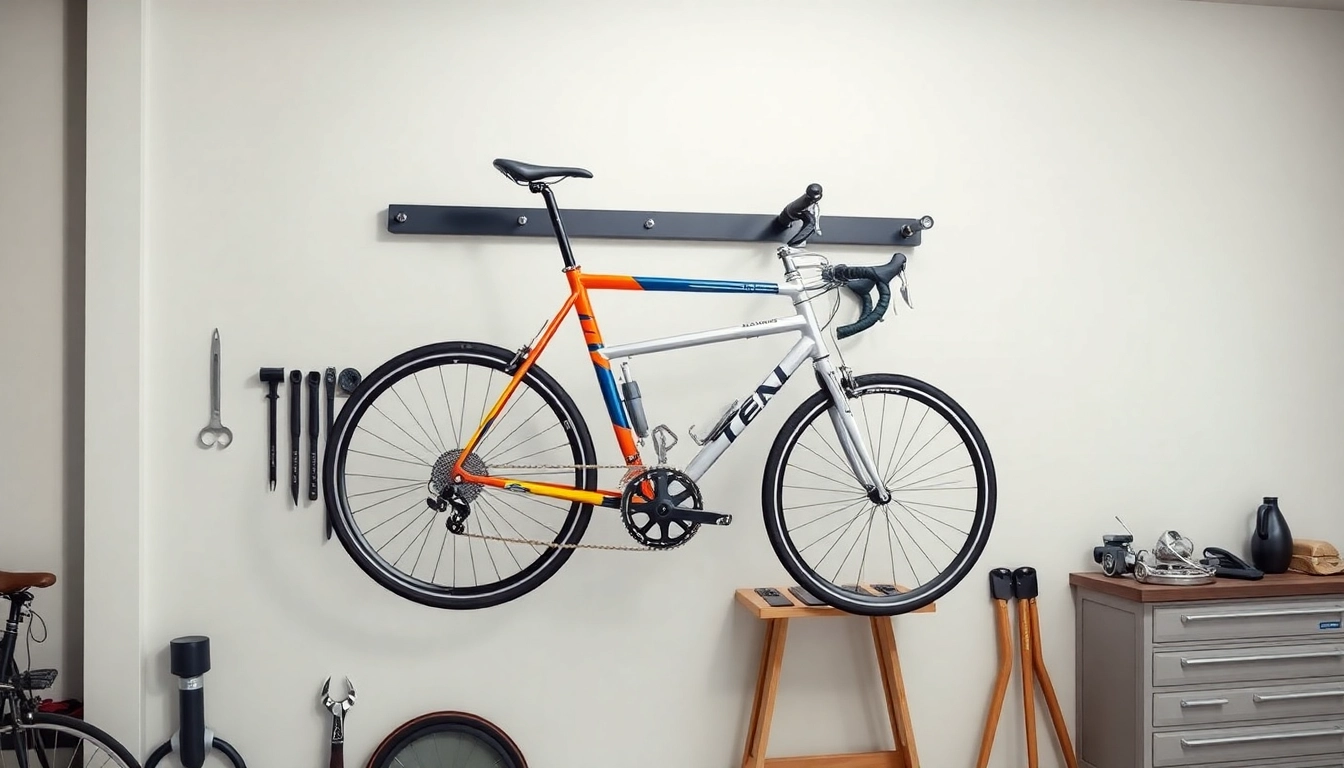Understanding the Bike Wall Rack
What is a Bike Wall Rack?
A Bike wall rack is a storage solution designed specifically for bicycles, allowing them to be mounted on a wall for efficient space utilization. These racks come in various designs, accommodating different types of bikes including road bikes, mountain bikes, and hybrids. Unlike traditional bike stands which require floor space, bike wall racks elevate bicycles off the ground, freeing up valuable space in garages, homes, and other areas.
Benefits of Using a Bike Wall Rack
Incorporating a bike wall rack into your storage solutions provides numerous benefits:
- Space Efficiency: Wall-mounted systems conserve ground space, making them particularly advantageous in compact areas.
- Accessibility: Elevating bikes off the ground allows easier access and visibility, ensuring that bikes can be quickly grabbed for a ride.
- Organization: A well-designed bike wall rack can help keep your bicycle and associated gear organized, reducing clutter and confusion.
- Maintenance: Storing bikes vertically can help prevent wear and tear that might occur when bikes lean against things or are stacked awkwardly.
Key Features to Look For
When selecting a bike wall rack, consider the following features:
- Weight Capacity: Ensure the rack can accommodate the weight of your bike and any additional accessories.
- Construction Material: Look for durable materials such as steel or heavy-duty plastic that can withstand the elements if installed outdoors.
- Security Features: Some models offer lock mechanisms to prevent theft, which is essential for urban environments.
- Adjustability: Adjustable designs can cater to various bike sizes and types, increasing the versatility of the rack.
Choosing the Right Bike Wall Rack
How to Measure Space for Your Bike Wall Rack
Before purchasing a bike wall rack, it’s crucial to accurately measure the available space. Here’s how:
- Identify Location: Choose a wall where you intend to mount the rack, ensuring it’s free from obstructions.
- Measure Width: Determine the width of the bike and check how much space you’ll need between multiple bikes if you plan to store more than one.
- Measure Height: Take into account the height at which you want to mount the rack. The average bike can be stored between 12 inches and 36 inches from the ground.
- Consider Surrounding Space: Ensure there’s enough room to maneuver while taking bikes off or putting them back on the rack.
Material Options for Durability
The construction material of your bike wall rack significantly affects its durability and longevity:
- Steel: Typically the strongest option, steel racks are resistant to bending and weather elements. Look for powder-coated finishes to prevent rust.
- Aluminum: Lightweight yet durable, aluminum is an excellent option for those seeking a non-corrosive material.
- Plastic: High-density plastic racks can be lightweight and easy to install, but may not support heavier bikes as effectively as metal options.
Types of Bike Wall Rack Designs
Bike wall racks come in various designs, each tailored for different needs:
- Vertical Racks: Hold bikes upright against the wall, ideal for maximizing floor space.
- Horizontal Racks: Bikes are mounted parallel to the ground. This style often allows more bikes to be stored close together.
- Swivel Racks: Can pivot to save space or make multiple bikes more accessible from various angles.
- Multi-Bike Racks: These can accommodate multiple bicycles, ideal for families or avid cyclists.
Installation Tips for Your Bike Wall Rack
Tools Required for Installation
Before starting the installation, gather the following tools:
- Drill
- Level
- Screwdriver
- Measuring tape
- Stud finder (if mounting on drywall)
- Safety goggles
Step-by-Step Installation Guide
Follow these steps for a successful bike wall rack installation:
- Select Location: Choose the most suitable wall and mark the area where you want to mount your rack.
- Check for Studs: Use a stud finder to locate wall studs, as securing into studs will provide maximum support.
- Mark Drill Points: Use the level to draw a line where the rack will be installed, marking the drill points on the wall.
- Drill Holes: Carefully drill the holes in the wall. Use wall anchors if you’re mounting on drywall alone.
- Attach the Rack: Mount the rack according to the manufacturer’s instructions, securing it tightly to the wall.
- Check Stability: Once installed, check to ensure the rack is sturdy and secure before placing your bike on it.
Common Mistakes to Avoid
To ensure a successful installation, watch out for these frequent errors:
- Ignoring Weight Limits: Be aware of the maximum weight capacity; exceeding it can result in damage or failure.
- Improper Measurements: Double-check your measurements to avoid selecting a rack that won’t fit your bikes or space.
- Neglecting Studs: Mounting to drywall only can lead to accidents; always find studs or use appropriate anchors.
Maintaining Your Bike Wall Rack
Regular Checks for Safety
Regular maintenance checks are vital in ensuring your bike wall rack remains safe and functional:
- Visual Inspections: Regularly inspect the rack for signs of wear, rust, or damage.
- Tightness Checks: Make sure screws and bolts remain tight, especially after extended use.
- Weight Monitoring: Keep track of how much weight is on the rack and ensure it doesn’t exceed the recommended limits.
Cleaning and Care Tips
Keeping your bike wall rack clean will prolong its lifespan:
- Dusting: Wipe down the rack regularly to remove dust and debris.
- Rust Prevention: If your rack is metal, apply a rust-resistant coating if you notice any signs of rust.
- Gear Maintenance: Ensure that the bikes themselves are regularly maintained to prevent grease and dirt from transferring onto the rack.
When to Replace Your Bike Wall Rack
There are specific signs that indicate it may be time to replace your bike wall rack:
- Signs of Wear: If you see cracks, bends, or significant rust, it’s time for a replacement.
- Stability Issues: If the rack feels unstable or wobbly after tightening, it may no longer be safe to use.
- Incompatibility: If you’ve upgraded to heavier bikes or more bikes than the current rack can accommodate, consider finding a new solution.
Complementing Your Bike Wall Rack with Accessories
Best Accessories for Your Bike Storage
Enhancing your bike storage setup can be done with several accessories:
- Hooks: Extra hooks can be added for helmets, gear bags, or additional accessories.
- Cradles: Specialized cradles can hold bikes more securely, especially for heavier models.
- Magnetic Tool Holders: Affix these to the wall for easy access to repair tools or accessories while you maintain your bike.
Enhancing Your Garage Organization
A bike wall rack can be complemented with other organization strategies:
- Vertical Storage Systems: Consider installing shelves above the bike rack for additional gear storage.
- Binning Systems: Use clear bins to categorize and store bike accessories.
- Labeling: Clearly label each bin or shelf for easier access to items when in a hurry.
Creative Ways to Display Your Bikes
Bikes can also be showcased as decorative pieces in your home or garage:
- Color Coordination: Arrange bikes by color for visually appealing displays.
- Artistic Racking: Some bike wall racks are designed to look artistic, adding style to your space.
- Highlighting Unique Features: If a bike has a unique design or color, consider making it the focal point of your display.



